The Bobolink & the Migratory Birds
Alternative content
Canaries at the Jabuticaba tree at FAF
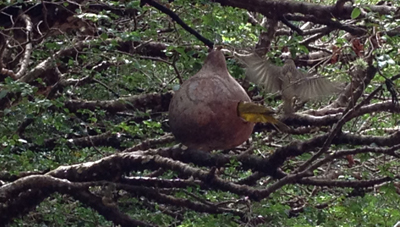
July 2012
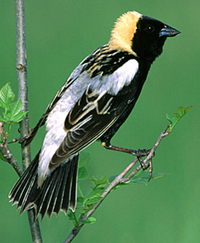 |
The Bobolink is polygynous and was one of the first species in which multiple paternity (females laying a clutch of eggs sired by more than one male) was documented. In addition, this North American breeder is an extraordinary migrant, traveling to south of the equator each autumn and making a round-trip of approximately 20,000 kilometers. One female known to be at least nine years old presumably made this trip annually, atotal distance equal to traveling 4.5 times around the earth at the equator! Why these birds make such an arduous journey each year is not as well understood as how they do it;
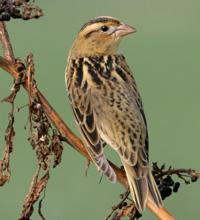 |
Bobolinks have been shot as agricultural pests in the southern United States, trapped and sold as pets in Argentina, and collected as food in Jamaica. The species is not as abundant as it was several decades ago, primarily because of changing land-use practices, especially the decline of meadows and hay fields. The Bobolink's tenacity and adaptability, however, should continue to serve it well.
Neotropical Migratory Bird Basics
 This lovely neotropical migrant has many remarkable features, but one of them makes this bird unique in North America. What is that?
This lovely neotropical migrant has many remarkable features, but one of them makes this bird unique in North America. What is that?
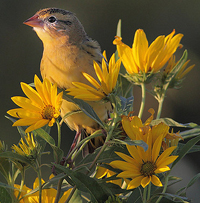 |
Male bobolinks are unique among North American avifauna because their breeding garb features a black belly accented by a pale colored topside.
Embedded below is a 2 minute radio programme about the bobolink, thanks to my friends at BirdNote Radio.
 What is a Neotropical migratory bird?
What is a Neotropical migratory bird? How many kinds are there?
How many kinds are there? How far do they travel?
How far do they travel?
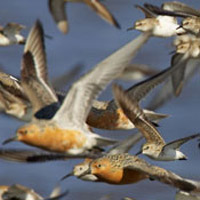 |
Examples of birds that make such relatively short migrations include all black-capped vireos and Lucy’s warblers, and some painted buntings, northern parulas, and gray catbirds.
Some of the longest migrations are made by shorebirds that nest in the arctic tundra of northernmost Canada and winter as far south as Tierra del Fuego (the southernmost part of South America), a one-way distance of up to 10,000 miles (16,000 kilometers). Red knots and white-rumped sandpipers are 2 species that make this remarkable journey.
Other birds that winter in South America, and thus travel great distances, include: common nighthawks, Swainson’s hawks, red-eyed vireos, purple martins, barn and cliff swallows, blackpoll, cerulean and Connecticut warblers, scarlet tanagers, and bobolinks. A round-trip migration distance for many of these species is as much as 13,600 miles (22,000 kilometers).
Although not technically a Neotropical migratory bird, no discussion of long-distance bird migration is complete without mention of the champion globe-trotter of all, the arctic tern.
With nesting grounds as far north as land extends and wintering sites on the opposite end of the earth, arctic terns cover 22,000 miles (35,400 km) annually. Given that the sun never sets while these terns are nesting, nor during the time they spend near the South Pole, arctic terns enjoy more hours of daylight than any other species.
| Species | Miles | Breeding Range | Wintering Range | |||||||||||
|---|---|---|---|---|---|---|---|---|---|---|---|---|---|---|
| Black-capped Vireo | 400-1,250 | Oklahoma, Texas | (w) Mexico | |||||||||||
| Lucy's Warbler | 500-1,500 | (sw) U.S. | (w) Mexico | |||||||||||
| Painted Bunting | 300-3,000 | (s) and (se) U.S. | Mexico to Panama, West Indies |
|||||||||||
| Northern Parula | 300-3,000 | (se) Canada, (e) U.S. |
Florida, West Indies, Mexico to Nicaragua |
|||||||||||
| Wood Thrush | 600-3,750 | (se) Canada, (e) U.S. |
Mexico to Panama | |||||||||||
| Scarlet Tanager | 600-4,350 | (se) Canada, (e) U.S. |
(nw) South America | |||||||||||
| Cerulean Warbler | 2,175-4,500 | (se) Canada, (e) U.S. |
(nw) South America | |||||||||||
| Blackpoll Warbler | 2,500-5,000 | Alaska, Canada, New England | (n) South America | |||||||||||
| Purple Martin | 600-6,000 | (s) Canada, U.S., Mexico | Brazil, Bolivia to (n) Argentina | |||||||||||
| Cliff Swallow | 1,250-6,800 | Alaska, Canada, U.S., (n) Mexico | (s) Brazil, Bolivia to (c) Argentina | |||||||||||
| Common Nighthawk | 2,500-6,800 | most of Canada and U.S. | Colombia to (c) Argentina | |||||||||||
| Bobolink | 5,000-6,800 | (s) Canada, (n) U.S. |
(s) Brazil to (n) Argentina | |||||||||||
| Swainson's Hawk | 3,750-7,500 | (sw) Canada, (w) U.S. |
(s) Brazil to (c) Argentina | |||||||||||
| Lesser Yellowlegs | 1,500-9,300 | Alaska, (n) Canada |
(s) U.S., West Indies, South America |
|||||||||||
| Red Knot | 1,500-10,000 | (n) Canada | coasts from (c) U.S. to southern tip of South America |
|||||||||||
|
||||||||||||||
 Why do Neotropical migratory birds fly so far?
Why do Neotropical migratory birds fly so far?
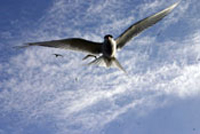 |
You may have guessed that they migrate south to avoid the cold of our winter, but there are many species of birds which can and do tolerate cold temperatures, as long as food is plentiful.
The types of food that Neotropical migratory birds need, such as flying insects, caterpillars, fruits and nectar, are super-abundant during our spring and summer, but are not sufficiently available through the winter.
Ultimately, the reason why migration persists is because it increases "breeding success", that is birds are able to raise more young on average by migrating than they would if they remained in the tropics. The abundant, protein-rich food, longer daylight hours, greater area over which the birds can spread, and, possibly, fewer predators account for the potential to raise more young.
 At what time do birds migrate?
At what time do birds migrate?Whereas the nocturnal migrants (that is, the ones that migrate at night) travel through the air by flapping their wings, birds such as hawks and vultures fly by soaring and gliding on rising currents of air.
These soaring birds must migrate by day, since the rising currents of air which enable them to soar form only during the day as the sun?s rays heat the earth. Swallows, swifts, and nighthawks are also diurnal migrants (that is, they migrate by day) because they feed on flying insects that are active only by day.
 How high do migrating birds fly?
How high do migrating birds fly?
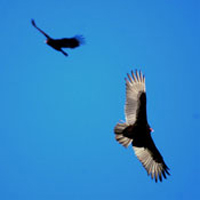 |
Because winds at higher altitudes are stronger than winds closer to the earth?s surface, birds fly higher with tailwinds (winds blowing in the direction in which the bird is migrating) and lower with headwinds (winds blowing in the opposite direction).
In general, nocturnal migrants travel at higher altitudes than diurnal migrants. Of the nocturnal migrants, most shorebirds and waterfowl fly higher on average than do songbirds. Most birds tend to fly higher when crossing large bodies of water than when flying over land.
Some of the highest flight altitudes are attained by shorebirds and a few songbirds that make long-distance, non-stop flights over water. For instance, blackpoll warblers, red knots, and American golden-plovers often travel at 5,000 feet (1,500 meters), and sometimes at more than 12,000 feet (3,600 meters), when flying over the Atlantic Ocean from southern, coastal Canada and New England to South America.
Most birds migrate within the following ranges of altitudes:
| Feet | Meters | 75% of songbirds migrate between 500 and 2,000 feet (150- 600 m) |
| Songbirds | 500-6,000* | 150-2,000* |
| Shorebirds | 1,000-13,000 | 300-4,000 |
| Waterfowl | 200-4,000 | 60-1,200 |
| Raptors | 700-4,000 | 200-1,200 |
(Birds are capable of flying at much higher altitudes. Bar-headed geese are known to cross the Himalayas at 29,500 feet (9,000 m). The world record holder is a Ruppell?s griffon vulture seen at 37,000 feet (11,300 m.) A mallard, which struck an airplane at 21,000 feet (6,400 m), holds the record for the highest documented flight altitude for a bird in North America.)
 How fast do birds fly when they are migrating?
How fast do birds fly when they are migrating?(25-70 kilometers per hour). Slower and faster flight speeds have been recorded, but they are exceptions. In general, larger birds fly faster than smaller birds. Below are typical flight speeds, given in miles per hour and kilometers per hour:
| Miles/Hour | Kilometers/Hour | |
| Songbirds | 10-30 | 15-50 |
| Shorebirds | 20-40 | 30-65 |
| Waterfowl | 30-50 | 50-80 |
| Raptors | 20-45 | 30-70 |
 How long does it take birds to migrate?
How long does it take birds to migrate? For example, a blackpoll warbler heading from Florida to Alaska may take as long as a month to cover the first 1000 miles (an average of about 30 miles a day), whereas the final 2500 miles may take only 2 weeks (an average of 180 miles per day). For most birds, the pace in the fall tends to be more leisurely and more evenly paced.
Typically, migration is accomplished in a series of flights lasting from several hours to several days. Between flights, birds make pit stops for resting and "re-fueling" which last anywhere from a day to a few weeks. Below are examples of approximate daily migration distances given as either an average or a range:
| Species | Miles/Day | Kilometers/Day |
|---|---|---|
| American Redstart | 20-100 | 30-160 |
| Barn Swallow | 90 | 150 |
| Blue-winged Teal | 100 | 160 |
| Swainson?s Thrush | 125 | 200 |
| Swainson?s Hawk | 106 | 170 |
| Red Knot | 90-600 | 140-960 |
| Broad-winged Hawk | 60-300 | 100-480 |
Average daily migration distances understate the amazing capabilities of migratory birds?capabilities that are put to the test when birds are faced with crossing large bodies of water.
For instance, when traveling to South America in the fall, blackpoll warblers depart from New England and the southern coast of Canada on a non-stop flight which takes a minimum of 72 hours. That?s 2,000 miles (3,200 km) in three days, or an average of 660 miles per day (1,000 km/day). This degree of exertion is equivalent to a human running 4-minute miles (15 mi/hr; 24 km/hr) for 80 consecutive hours. How do birds know when to migrate?
How do birds know when to migrate? Southbound migration timing may be fine-tuned by changes in day length. The environmental factors operating on the wintering grounds, where day length is relatively constant, are more subtle and less well understood.
 How do they know where to go?
How do they know where to go?For most long distance migrants, birds are born genetically programmed to fly in a certain direction for a certain amount of time. The first migration is completely under genetic control. As birds gain experience, they incorporate learned information. For instance, if they find a particular breeding or wintering location that is good, they may return to this location in the future by relying on learned information.
 How do they know which direction to fly?
How do they know which direction to fly?
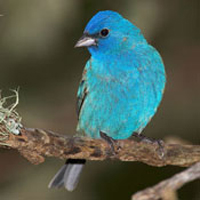 |
If young buntings are prevented from seeing the night sky during a critical stage in their development, they will not be able to orient properly for migration. This ability, therefore, is learned rather than genetically programmed. Other nocturnal migrants probably also use stars for compass direction.
Although the intricacies of how birds navigate remain a mystery, this much seems to hold true: all migratory birds use a variety of cues, and different species seem to rely on some cues more than others. This can vary according to the immediate circumstances, for example, if it is a cloudy night and the stars are obscured, a nocturnal migrant many rely more on other sources of information.
Other cues used by migratory birds include:
- the earth?s magnetic fields,
- location of the setting sun (and the pattern of polarized light created),
- topographic features of the landscape (coastlines, rivers, mountain ranges, for example),
- and prevailing wind patterns (wind patterns are seasonal; during migration the wind tends to blow in roughly the appropriate direction for migration).
- Bird Migration: A General Survey, Peter Berthold, 1993, Oxford Univeristy Press Inc., New York.
- Bring Back the Birds, Russell Greenberg and Jamie Reaser, 1995, Stackpole Books, Mechanicsburg, PA.
- How Birds Migrate, Paul Kerlinger, 1995, Stackpole Books, Mechanicsburg, PA.
- Optimal Migration, special issue of the Journal of Avian
Biology, vol 29, No.4,
Dec 1998. - Random House Atlas of Bird Migration: Tracing the Journey?s of the World?s Birds, edited by Jonathan Elphick, 1995, Random House, New York.
More migratory bird fact sheets
 | ||



 Top
Top